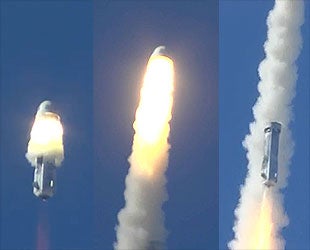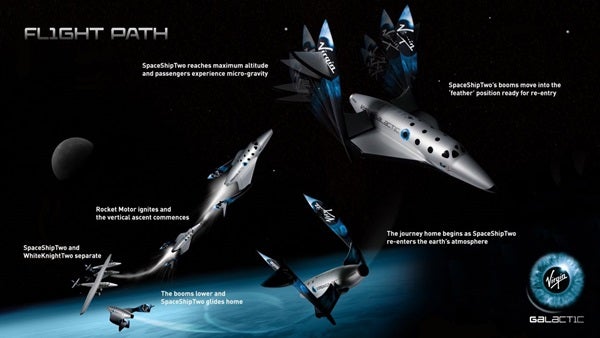SpaceX made international headlines this May when their Crew Dragon spacecraft blasted into orbit aboard a Falcon 9 rocket, carrying astronauts Doug Hurley and Bob Behnken to the International Space Station. But what some astute viewers may have noticed during liftoff is that Crew Dragon did not have a traditional launch escape system (LES) tower on top of its nose cone.
So, what is the emergency exit plan for astronauts during a failed Crew Dragon launch? And how do the LES of other commercial spacecraft work?
Abort!
LES towers, first designed by Maxime Faget, have been employed since the 1960s. They depend on escape rockets — typically utilizing solid propellant — that quicky lift the spacecraft away from what is presumed to be an exploding rocket. These escape rockets then carry the spacecraft to a safe altitude for parachute deployment before separating from the crew capsule.
Instead of an LES, Project Gemini used a highly controversial ejection seat system that violently threw astronauts away from the booster in the event of an emergency. But Mercury and Apollo astronauts both trusted LES towers, as well as the Russian Soyuz and Chinese Shenzou programs.
SpaceX: Escaping Crew Dragon
Elon Musk’s SpaceX has proven to be nothing if not innovative. While recognizing that crewed spacecraft must have an escape system, SpaceX has gone in a different direction with their LES. The Crew Dragon has eight SuperDraco engines incorporated into the body of the spacecraft itself, none of which utilize an external tower.
In a further break from tradition, the SuperDraco engine utilizes liquid propellants, which are more controllable than solid propellants. These storable, stable liquid propellants are the hypergolic agents monomethylhydrazine and dinitrogen tetroxide, with the latter functioning as the oxidizer. These propellants do not need an external ignition source. Hypergolic fuels ignite on contact with each other, further simplifying the design of the engine — and, of key importance, allowing the engine itself to be restarted.
Engines that use hypergolic fuels have been shown to be extremely reliable (the Apollo Service Module’s engine used hypergolic fuel, as did the Lunar Module’s descent and ascent engines). But to prove they were ready for crewed flights of Crew Dragon, SpaceX performed a full launch abort test of their spacecraft on January 19. 2020, intentionally destroying a Falcon 9 rocket in the process.
Blue Origin: Escaping New Shepard and New Glenn
Blue Origin, another private spacecraft venture funded by Amazon founder Jeff Bezos, is not as far along in terms of development as SpaceX, but they are making undeniable progress. Blue Origins program currently has two spacecraft in development: the suborbital New Shepard (a reference to Alan Shepard’s suborbital Freedom 7 flight) and the orbital New Glenn (a reference to John Glenn’s orbital Friendship 7 fight).
In the event of an emergency during launch, New Shepard uses a small solid rocket motor — designed and successfully tested by Aerojet Rocketdyne and located underneath the crew capsule — to separate the capsule from the rocket booster. The capsule can then be steered during the escape by a thrust vector control system. Once clear of the threat, the capsule releases parachutes to allow for a safe landing. The New Glenn spacecraft is still in development, but it seems likely it will use a similar (if not identical) escape system as New Shepard.
Boeing: Escaping CST-100 Starliner
Boeing has spent the past several years working on its own commercial spacecraft system, the CST-100 Starliner. While SpaceX and Blue Origin have trailblazed some new designs, the Starliner is outwardly reminiscent of the Apollo Command Module — a proven design.
But like SpaceX and Blue Origin, Boeing’s Starliner does not use an LES tower. Instead, the spacecraft’s hull incorporates four liquid-fueled launch abort engines, which combine to produce a staggering 160,000 pounds of thrust. These engines work in concert with the craft’s orbital maneuvering and attitude control (OMAC) thrusters, helping properly orient the capsule and keep it stable during the abort. Once free of the booster, the service and crew modules separate so the parachutes can be deployed. The spacecraft also jettisons its heat shield and inflates external airbags before making a soft landing.
Founded by British billionaire Richard Branson, Virgin Galactic uses a completely novel system to put humans in space: a ground-launched mothership aircraft (White Knight Two) carries a daughter spacecraft (SpaceShipTwo) to an altitude of some 50,000 feet (15,000 meters). White Knight then releases SpaceShipTwo before the daughter craft ignites its own rocket engine and ascents into suborbital space, peaking at an altitude of about 63 miles (110 km).
But on October 31, 2014, Virgin Galactic’s second-generation spacecraft, VSS Enterprise, broke apart after being released from the mothership and igniting its rocket engine. The cause of the failure was determined to be the result of a premature deployment of the braking system, which caused the spacecraft to disintegrate mid-flight.
Pilot Peter Siebold was thrown free of the disintegrating craft at a height of no less than 50,000 feet (15,000 meters) wearing only a flight suit. Fortunately, he was able to parachute to Earth after initially freefalling at supersonic speeds. Though he suffered serious injuries, Siebold survived. Co-pilot Michael Alsbury did not.
Little information is publicly available regarding Virgin Galactic’s emergency escape plans for future commercial spaceflights, which they aim to begin in 2021.
Sierra Nevada: Escaping Dream Chaser
The Sierra Nevada corporation is currently working on the Dream Chaser — a reusable, lifting-body spaceplane that is somewhat reminiscent of the famed Boeing X-20 Dyna Soar. Engineers are designing the Dream Chaser to be vertically launched atop an Atlas V or Vulcan-Centaur booster rocket.
The exact specifications of the spacecraft’s planned LES are not certain at this point. But some have speculated that it might be similar to that designed for NASA’s HL-20 spaceplane — which the Dream Chaser also greatly resembles. The HL-20 uses integrated solid rocket motors to quickly flee a dangerous rocket booster during a crisis. But unlike parachute-based systems, the Dream Chaser could then use its aerodynamic shape to land horizontally on a nearby runway.
More than one way to skin save a cat
It’s worth noting that tower-based LES typically require a so-called boost protective cover on top of the capsule. This limits the astronaut’s visibility during launch until the cover is released, which usually occurs when the tower flies away after the initial flight is deemed safe. Integrated escape systems — like those employed by SpaceX, Blue Origin, and Boeing — need no such cover atop the spacecraft.
These various approaches to LES show that there is no singular “best” way to design an emergency escape system for a spacecraft. All invoke the simple notion that the crew needs to feel a failing rocket booster as quickly as possible, and then get back to the ground in one piece.
It’s worth noting that all of the commercial spacecraft described in this article are experimental — though Crew Dragon aims to begin its first official NASA mission later today. During any launch, but especially aboard experimental craft, it’s necessary to have a trustworthy escape plan.
Astronaut Nick Hague and Cosmonaut Aleksey Ovchinin discovered this firsthand in 2018, when their Soyuz MS-10 flight experienced a launch abort due to the second stage of their rocket booster breaking up during the flight. Fortunately, the LES integrated into their capsule activated and perfectly carried out its only job: saving their lives.
So, keep in mind, while a rocket booster might occasionally fail, an LES never has.
Doug Adler is the co-author of From The Earth to the Moon: The Miniseries Companion












